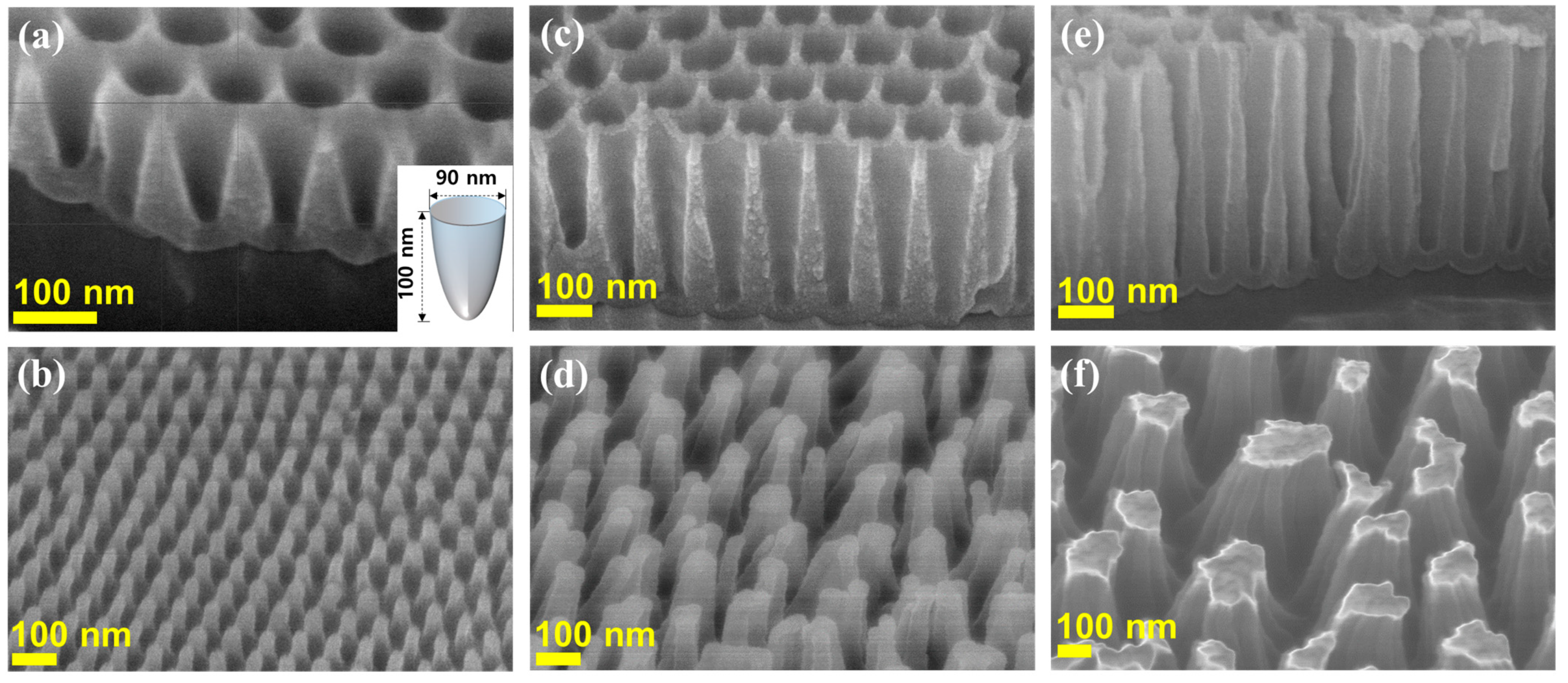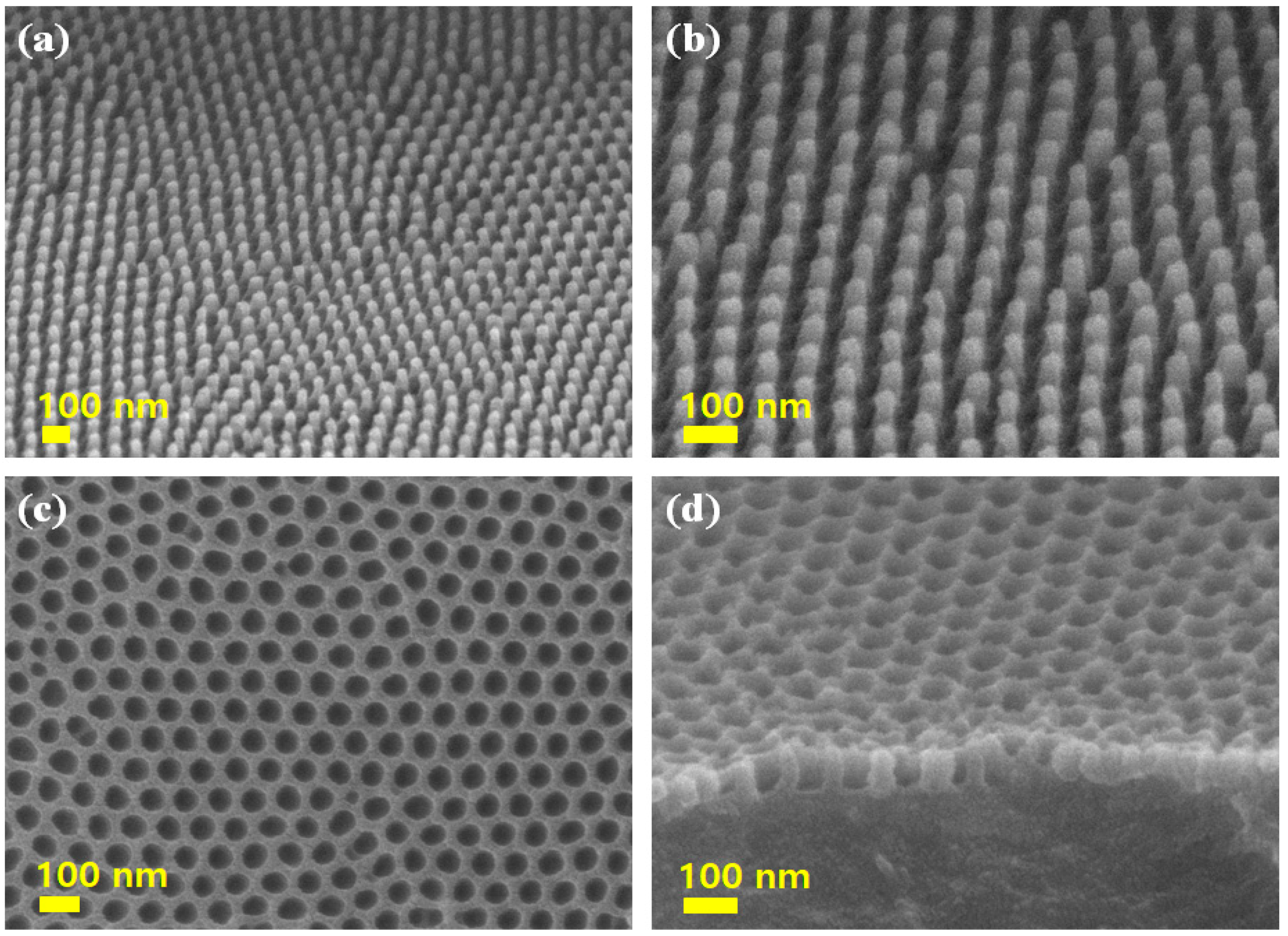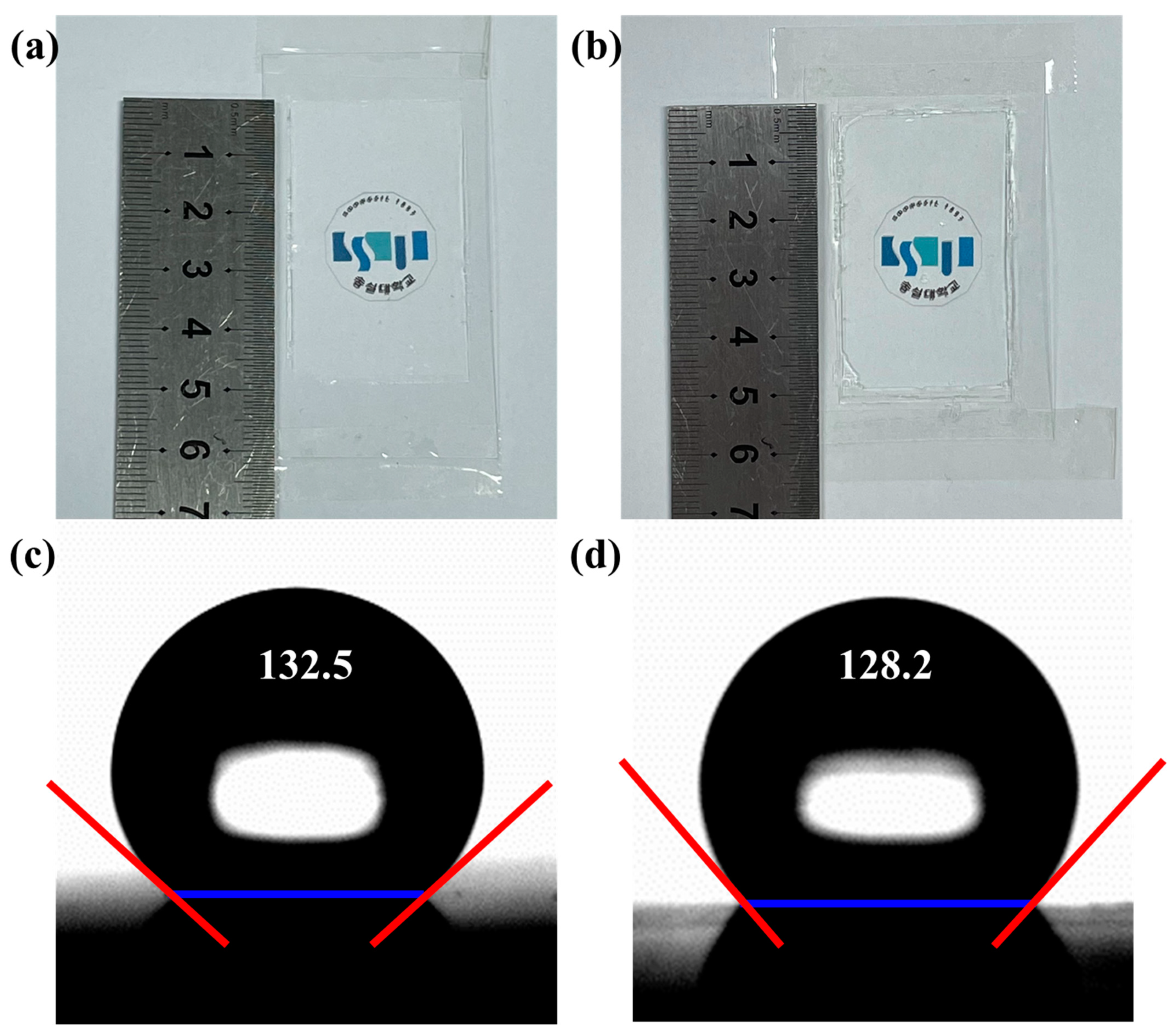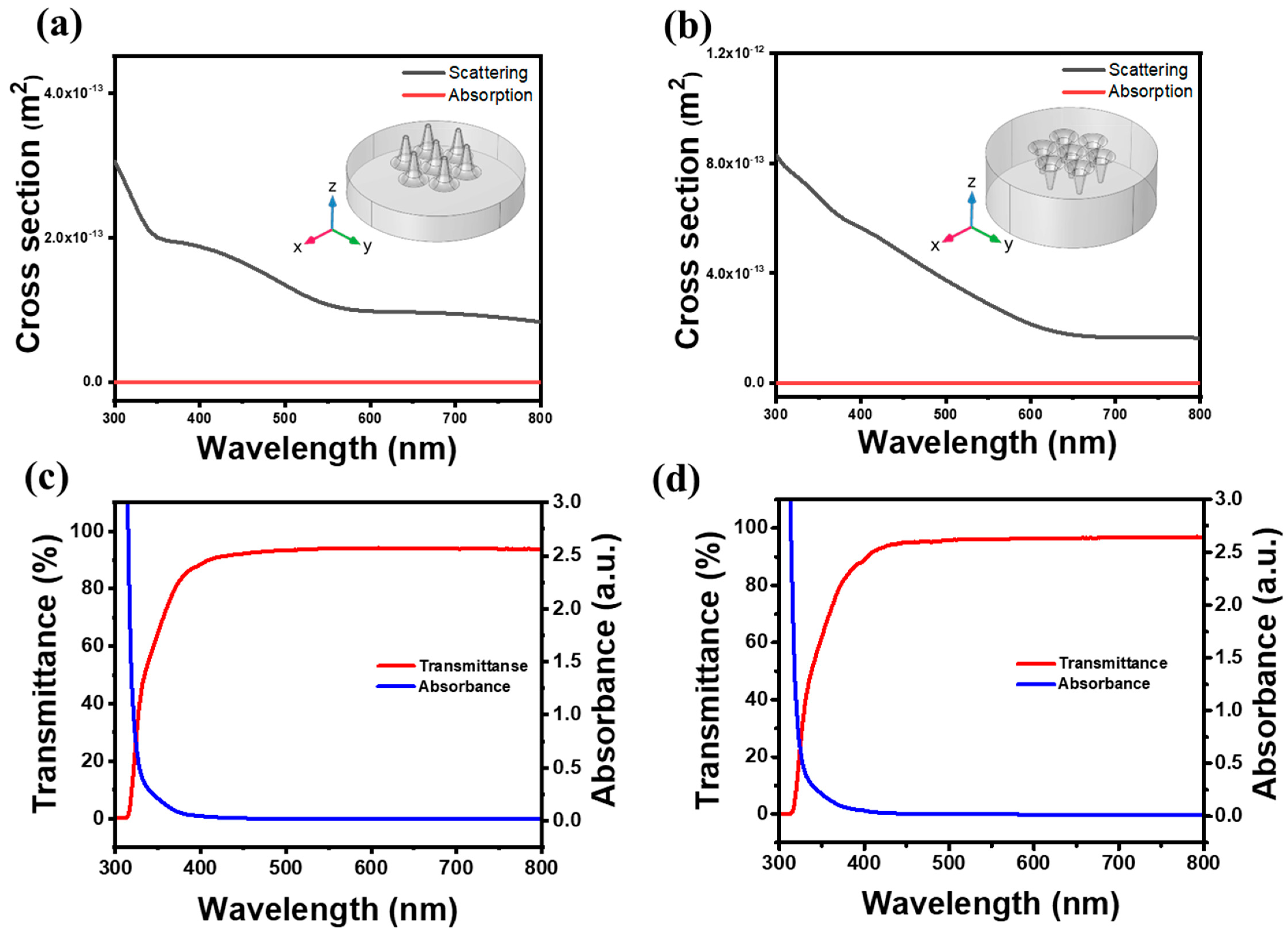Nanopatterned Polymer Molds Using Anodized Aluminum Templates for Anti-Reflective Coatings
Abstract
:1. Introduction
2. Materials and Methods
2.1. Materials
2.2. Preparation and Surface Modification of Moth-Eye-Inspired Polymer Nanostructures
2.3. Physicochemical Characterization and COMSOL Multiphysics Simulation
3. Results and Discussion
4. Conclusions
- Both embossed and engraved nanopatterned polymeric mold structures were tested for potential applications in transparent coating.
- Only an AAO master mold in the depth of 100 nm is found to be eligible to produce a stable embossed polymer mold shape.
- The neighboring apexes in nanocones appeared to be amalgamated for the 300 and 500 nm templates in depth.
- Contact angle measurements of the embossed and concaved polymer surfaces were estimated to be 132.5 (±2.7)° and 128.2 (±0.9)°, respectively.
- Concaved molds showed approximately 2% higher transmittance values than those of the embossed ones.
Author Contributions
Funding
Institutional Review Board Statement
Informed Consent Statement
Data Availability Statement
Acknowledgments
Conflicts of Interest
References
- Ho, T.T.-T.; Dang, C.-H.; Hyunh, T.K.-H.; Hoang, T.K.-D.; Nguyen, T.-D. In situ synthesis of gold nanoparticles on novel nanocomposite lactose, alginate: Recyclable catalysis and colorimetric detection of Fe(III). Carbohydr. Polym. 2021, 251, 116998. [Google Scholar] [CrossRef]
- Xiao, Y.; Luo, H.; Tang, R.; Hou, J. Preparation and applications of electrospun optically transparent fibrous membrane. Polymers 2021, 13, 506. [Google Scholar] [CrossRef] [PubMed]
- Qaid, S.M.H.; Ghaithan, H.M.; AlHarbi, K.K.; Al-Asbahi, B.A.; Aldwayyan, A.S. Enhancement of light amplification of CsPbBr3 perovskite quantum dot films via surface encapsulation by PMMA polymer. Polymers 2021, 13, 2574. [Google Scholar] [CrossRef]
- Motamedi, M.; Warkiani, M.E.; Taylor, R.A. Transparent surfaces inspired by nature. Adv. Opt. Mater. 2018, 1, 1800091. [Google Scholar] [CrossRef]
- Raut, H.K.; Ganesh, V.A.; Nairb, A.S.; Ramakrishna, S. Anti-reflective coatings: A critical, in-depth review. Energy Environ. Sci. 2011, 4, 3779–3804. [Google Scholar] [CrossRef]
- Stavenga, D.G.; Foletti, S.; Palasantzas, G.; Arikawa, K. Light on the moth-eye corneal nipple array of butterflies. Proc. R. Soc. B 2006, 273, 661–667. [Google Scholar] [CrossRef] [Green Version]
- Córdova-Castro, R.M.; Krasavin, A.V.; Nasir, M.E.; Zayats, A.V.; Dickson, W. Nanocone-based plasmonic metamaterials. Nanotechnology 2019, 30, 055301. [Google Scholar] [CrossRef]
- Zhangyang, X.; Liu, L.; Lv, Z.; Lu, F.; Tian, J. The effect of geometry parameters on light harvesting performance of GaN nanostructure arrays—A numerical investigation and simulation. Mater. Res. Express 2020, 7, 015009. [Google Scholar] [CrossRef]
- Ko, D.-H.; Tumbleston, J.R.; Henderson, K.J.; Euliss, L.E.; DeSimone, J.M.; Lopez, R.; Samulski, E.T. Biomimetic microlens array with antireflective “moth-eye” surface. Soft Matter 2011, 7, 6404–6407. [Google Scholar] [CrossRef]
- Fan, Y.; Song, Y.; He, N.; Cheng, F.; Jiao, X.; Lai, G.; Hua, X.; Yang, X. High efficiency and low migration hyperbranched silicone contain macrophotoinitiators for UV-cured transparent coatings. Polymers 2020, 12, 3005. [Google Scholar] [CrossRef]
- Jin, B.; He, J. Self-templated fabrication of robust moth-eye-like nanostructures with broadband and quasi-omnidirectional antireflection properties. ACS Photonics 2016, 4, 188–196. [Google Scholar] [CrossRef]
- Zhu, Y.; Shu, L.; Zhang, Q.; Zhu, Y.; Poddar, S.; Wang, C.; He, Z.; Fan, Z. Moth eye-inspired highly efficient, robust, and neutral-colored semitransparent perovskite solar cells for building-integrated photovoltaics. EcoMat 2021, 3, e12117. [Google Scholar] [CrossRef]
- Xu, J.; Wang, Z.; Zhang, Z.; Wang, D.; Weng, Z. Fabrication of moth-eye structures on silicon by direct six-beam laser interference lithography. J. Appl. Phys. 2014, 115, 203101. [Google Scholar] [CrossRef]
- Xie, S.; Wan, X.; Yang, B.; Zhang, W.; Wei, X.; Zhuang, S. Design and fabrication of wafer-level microlens array with moth-eye antireflective nanostructures. Nanomaterials 2019, 9, 747. [Google Scholar] [CrossRef] [PubMed] [Green Version]
- Tan, G.; Lee, J.-H.; Lan, Y.-H.; Wei, M.-K.; Peng, L.-H.; Cheng, I.C.; Wu, S.-T. Broadband antireflection film with moth-eye-like structure for flexible display applications. Optica 2017, 4, 678–683. [Google Scholar] [CrossRef]
- Liu, X.; Li, K.; Shen, J.; Gong, F. Hot embossing of moth eye-like nanostructure array on transparent glass with enhanced antireflection for solar cells. Ceram. Inter. 2021, 47, 18367–18375. [Google Scholar] [CrossRef]
- Xie, H.; Xu, W.H.; Jia, S.H.; Wu, T. Tunable fabrication of biomimetic polypropylene nanopillars with robust superhydrophobicity and antireflectivity. Nanotechnology 2021, 32, 395301. [Google Scholar] [CrossRef] [PubMed]
- Wang, Z.; Ding, H.; Liu, D.; Xu, C.; Li, B.; Niu, S.; Li, J.; Liu, L.; Zhao, J.; Zhang, J.; et al. Large-scale bio-inspired flexible antireflective film with scale-insensitivity arrays. ACS Appl. Mater. Interfaces 2021, 13, 23103–23112. [Google Scholar] [CrossRef]
- Ducros, C.; Brodu, A.; Lorin, G.; Emieux, F.; Pereira, A. Optical performances of antireflective moth-eye structures. Comparison with standard vacuum antireflection coatings for application to outdoor lighting LEDs. Surf. Coat. Technol. 2019, 379, 125044. [Google Scholar] [CrossRef]
- Zhao, Q.; Liu, G.; Zhang, H.; Zhou, F.; Li, Y.; Cai, W. SERS-based ultrasensitive detection of organophosphorus nerve agents via substrate’s surface modification. J. Hazard Mater. 2017, 324, 194–202. [Google Scholar] [CrossRef]
- Liu, J.; Jiao, X.; Cheng, F.; Fan, Y.; Wu, Y.; Yang, X. Fabrication and performance of UV cured transparent silicone modified polyurethane–acrylate coatings with high hardness, good thermal stability and adhesion. Prog. Org. Coat. 2020, 144, 105673. [Google Scholar] [CrossRef]
- Park, J.; Lim, T.; Yang, K.H.; Ju, S.; Jeong, S.M. Dipping-press coating method for retaining transparency and imparting hydrophobicity regardless of plastic substrate type. Polymers 2021, 13, 403. [Google Scholar] [CrossRef] [PubMed]
- Kim, T.K.; Park, J.S.; Kim, S.H.; Jung, W.T. Structural behavior evaluation of reinforced concrete using the fiber-reinforced polymer strengthening method. Polymers 2021, 13, 780. [Google Scholar] [CrossRef] [PubMed]
- Huang, Y.J.; Chang, R.; Zhu, Q.J. Synthesis and characterization of a molecularly imprinted polymer of spermidine and the exploration of its molecular recognition properties. Polymers 2018, 10, 1389. [Google Scholar] [CrossRef] [PubMed] [Green Version]
- Jiao, X.; Liu, J.; Jin, J.; Cheng, F.; Fan, Y.; Zhang, L.; Lai, G.; Hua, X.; Yang, X. UV-cured transparent silicone materials with high tensile strength prepared from hyperbranched silicon-containing polymers and polyurethane-acrylates. ACS Omega 2021, 6, 2890–2898. [Google Scholar] [CrossRef] [PubMed]
- Othman, N.A.F.; Selambakkannu, S.; Abdullah, T.A.T.; Hoshina, H.; Sattayaporn, S.; Seko, N. Selectivity of copper by amine-based ion recognition polymer adsorbent with different aliphatic amines. Polymers 2019, 11, 1994. [Google Scholar] [CrossRef] [PubMed] [Green Version]
- Lee, J.; Hwang, H.S.; Lo, T.N.H.; Koh, W.G.; Park, I. Effect of silica size and content on superamphiphobic properties of silica-fluoropolymer core-shell coatings. Polymers 2020, 12, 2864. [Google Scholar] [CrossRef]
- Jahani, Y.; Baena, M.; Gomez, J.; Barris, C.; Torres, L. Experimental study of the effect of high service temperature on the flexural performance of near-surface mounted (NSM) carbon fiber-reinforced polymer (CFRP)-strengthened concrete beams. Polymers 2021, 13, 920. [Google Scholar] [CrossRef]
- Lee, H.; Jung, W.T.; Chung, W. Post-tension near-surface mounted strengthening system for reinforced concrete beams with changes in concrete condition. Compos. Part B-Eng. 2019, 161, 514–529. [Google Scholar] [CrossRef]
- Seong, K.-D.; Jung, J.-Y.; Kang, J.; Kim, D.-S.; Lyu, L.; Seo, S.; Kim, J.-H.; Piao, Y. Direct printing of high-performance microsupercapacitors on flexible substrates using polymeric stencil masks with highly precise interdigitated patterns. J. Mater. Chem. A 2020, 8, 25986–25994. [Google Scholar] [CrossRef]
- Choi, H.S.; Suh, S.J.; Kim, S.W.; Kim, H.J.; Park, J.W. Transparent Electromagnetic Shielding Film Utilizing Imprinting-Based Micro Patterning Technology. Polymers 2021, 13, 738. [Google Scholar] [CrossRef] [PubMed]
- Han, G.; Nguyen, T.B.; Park, S.; Jung, Y.; Lee, J.; Lim, H. Moth-eye mimicking solid slippery glass surface with icephobicity, transparency, and self-healing. ACS Nano 2020, 14, 10198–10209. [Google Scholar] [CrossRef] [PubMed]
- Han, Z.; Wang, Z.; Li, B.; Feng, X.; Jiao, Z.; Zhang, J.; Zhao, J.; Niu, S.; Ren, L. Flexible Self-Cleaning Broadband Antireflective Film Inspired by the Transparent Cicada Wings. ACS Appl. Mater. Interfaces 2019, 11, 17019–17027. [Google Scholar] [CrossRef] [PubMed]





| Replica Embossed Mold from Master AAO | Concaved Mold from Embossed Polymer Mold | |
|---|---|---|
| Mean | 132.5 | 128.2 |
| Standard deviations | 2.7 | 0.9 |
| Wavelength | |||||
|---|---|---|---|---|---|
| 400 nm | 500 nm | 600 nm | 700 nm | 800 nm | |
| Transmittance (%) | 88.6 (±1.0) | 93.4 (±0.6) | 94.2 (±0.5) | 94.0 (±0.5) | 93.9 (±0.5) |
| Absorbance (a.u.) | 0.044 (±0.014) | 0.018 (±0.012) | 0.017 (±0.011) | 0.017 (±0.012) | 0.016 (±0.012) |
| Wavelength | |||||
|---|---|---|---|---|---|
| 400 nm | 500 nm | 600 nm | 700 nm | 800 nm | |
| Transmittance (%) | 88.9 (±1.0) | 95.8 (±0.8) | 96.4 (±0.7) | 96.8 (±0.6) | 96.9 (±0.5) |
| Absorbance (a.u.) | 0.054 (±0.0048) | 0.021 (±0.0044) | 0.017 (±0.0027) | 0.014 (±0.0014) | 0.013 (±0.001) |
Publisher’s Note: MDPI stays neutral with regard to jurisdictional claims in published maps and institutional affiliations. |
© 2021 by the authors. Licensee MDPI, Basel, Switzerland. This article is an open access article distributed under the terms and conditions of the Creative Commons Attribution (CC BY) license (https://creativecommons.org/licenses/by/4.0/).
Share and Cite
Lim, S.H.; Ly, N.H.; Lee, J.A.; Kim, J.E.; La, S.-W.; Huong, V.T.; Tran, T.-G.; Ho, N.T.; Noh, S.M.; Son, S.J.; et al. Nanopatterned Polymer Molds Using Anodized Aluminum Templates for Anti-Reflective Coatings. Polymers 2021, 13, 3333. https://doi.org/10.3390/polym13193333
Lim SH, Ly NH, Lee JA, Kim JE, La S-W, Huong VT, Tran T-G, Ho NT, Noh SM, Son SJ, et al. Nanopatterned Polymer Molds Using Anodized Aluminum Templates for Anti-Reflective Coatings. Polymers. 2021; 13(19):3333. https://doi.org/10.3390/polym13193333
Chicago/Turabian StyleLim, Soon Hyuk, Nguyễn Hoàng Ly, Jung A. Lee, Ji Eun Kim, Se-Woong La, Vu Thi Huong, Thi-Giang Tran, Ngoc Thanh Ho, Seung Man Noh, Sang Jun Son, and et al. 2021. "Nanopatterned Polymer Molds Using Anodized Aluminum Templates for Anti-Reflective Coatings" Polymers 13, no. 19: 3333. https://doi.org/10.3390/polym13193333







